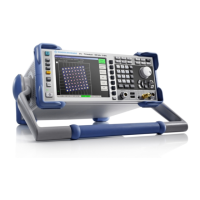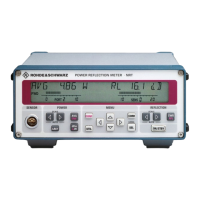R&S FSH Two-port measurements with the tracking generator
1309.6275.12 4.47 E-2
When the tracking generator is on, measurement parameters like bandwidth or the frequency range are
s
elected with the appropriate keys as in the spectrum analyzer mode. When the MEAS key is pressed,
the softkey menu for the tracking generator is displayed.
Before calibration, the output level of the tracking generator, the frequency range you want and the
a
ppropriate reference level should be set because calibration is only valid for the calibrated frequency
range and reference. Changing these parameters after calibration invalidates calibration.
Note: The calibration remains valid if the start frequency, stop frequency, center frequency and span
are subsequently changed within the calibrated frequency range. In this case, the R&S FSH
interpolates the correction data between the reference points of the calibration. The R&S FSH retains
the calibration values but displays a red dot before the tracking generator status display to indicate a
possible increase in measurement uncertainty.
With an integrated VSWR bridge (models R&S FSH4, order number 1309.600.24 and R&S FSH8, order
number 1309.600.28) the R&S FSH can measure the match at both the input and the output of a DUT
and the transmission from input to output and vice versa (2-port capability). For this purpose, it
internally switches the tracking generator to each of the required N-connectors, which are labelled port
1 and port 2 for this purpose.
Note: In spectrum analysis mode, port 1 is used as the RF input.
In devices which are not equipped with a VSWR bridge (Models R&S FSH4, order number 1309.600.14
and R&S FSH8, order number 1309.600.18), the generator output switching option is absent. These
devices can therefore measure only the transmission from the tracking generator output (= port 2) to the
RF input (= port 1) (TRANSMISSION REVERSE PORT 2 -> PORT 1). These devices also measure
only the transmitted power (scalar measurement). The phase response cannot be measured by means
of the measurement object.
Calibration is therefore available, regardless of the device model, in different versions:
Full Two-Port: Reference measurements are performed for transmission and reflection
measurement at both measurement ports (ports 1 and 2). This means that
all measurements in “Network” mode are performed with maximum
accuracy. The indication ‘(CAL)’ shows in the status display. With regards
to subsequent measurements at the DUT, this calibration method is the
most flexible. However, it is also the most time-consuming, because all
calibration standards (Open, Short, Load, Through) must be connected to
both ports, which requires a total of seven measurement steps.
Reflection Port 1: Performs vector reference measurements for later measurement of match
or reflection at port 1. In this case, calibration requires the calibration
standards to be connected to a single RF connector (3 measurement
steps).
Transmission Fwd: Performs vector reference measurements for the transmission from port 1
to port 2.
Transmission Rev: Performs vector reference measurements for the transmission from port 2
to port 1.
Reflection Port 2: Performs vector reference measurements for later measurement of match
or reflection at port 2.
Normalize …: When selecting a normalization, a single reference measurement is made
at the corresponding port or between both ports. By means of this
reference measurement, for example, the frequency and phase response
of a connected measurement cable can be compensated accurately
enough without having to carry out a time-consuming full calibration.
Note: In SCALAR mode and in instrument models without the VSWR
bridge, only the NORMALIZE calibration type is provided.

